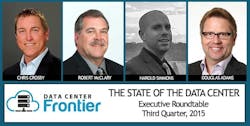Welcome to our first Data Center Executive Roundtable, a quarterly feature showcasing the insights of thought leaders on the state of the data center industry, and where it is headed. In our Fall 2015 roundtable, we will examine four topics: the impact of cloud computing, the evolution of data center markets, the role of pre-fabrication and modular design, and the innovation landscape in data center cooling.
Here’s a look at our distinguished panel:
- Chris Crosby, the founder and CEO of Compass Datacenters, a recognized visionary with more than 20 years experience in the data center space. Chris previously served as a Senior Vice President and founding member of Digital Realty Trust, as well as Proferian/GI Partners and CRG West (now Coresite).
- Robert McClary, Senior Vice President and General Manager for FORTRUST, a premier data center services provider and colocation facility. Robert is responsible for the overall supervision of business operations, high-profile construction and strategic technical direction for FORTRUST.
- Harold Simmons, Global Director of Strategy and Mission Critical Solutions for United Metal Products, a leading manufacturer of data center cooling equipment. Simmons works with Fortune 500 companies on their infrastructure strategy and work with his team to innovate/deploy cooling solutions to meet data center owners’ energy efficiency goals.
- Douglas Adams, Founding Executive and Senior Vice President of RagingWire Data Centers, has more than 25 years of industry experience. During his tenure with RagingWire, the company has grown from a start-up to an industry leader with nearly 1 million square feet of data center space in the United States.
Each day this week we will present a Q&A with these executives on one of our key topics. We begin our discussion by looking at the biggest trend shaping the industry:
The Rise of Cloud Computing
Data Center Frontier: How is the rise of cloud computing impacting the data center market? How do you see this trend playing out between major public clouds, service providers and in-house corporate data centers?
Chris Crosby, Compass Datacenters: Certainly the cloud has had an impact on the dynamics of the data center market from the standpoint of offering end users another alternative to choose from, but I think its impact tends to be somewhat overstated in terms of taking over the enterprise.
The common misconception is that the cloud obviates the need for data centers, or at least the total number of facilities required. I think this is a fallacious assumption, since the cloud is really just an amalgamation of components that are housed within multiple data centers. What the cloud has done is to provide new revenue streams for service providers, like Equinix, for example, since it enables them to offer end users a direct connection to cloud based applications. Additionally, it has provided the enterprise with a new paradigm to look at how to control IT costs more effectively.
Chris Crosby, CEO, Compass Datacenters
However, the single biggest impact for the cloud has been the elimination of the data center closet for the small business. A small business owner no longer has to have an email server and storage device. The ability to buy applications as-needed for the small business has led to a big shift in thinking about whether or not small business IT closets are needed. Of course, this trend has been going on for a long time (Rackspace was founded in 1998).
While this has certainly had an impact on the smaller company end of the market, there is a behavioral component that characterizes the vast majority of companies that most prognosticators seem to miss: the underlying need for control. in an Atlantic Monthly article, Frank Quattrone once talked about the concept of “career risk” when referring to financial bubbles. People do risky deals in financial bubbles because NOT doing them has more career risk when all your competitors are doing them. There is still a lot of perceived “career risk” to go to the cloud wholesale for a large company. Theoretical IT cost savings and future-proofing are great, until you start thinking about the risk-reward profile. In the world of enterprise IT, the reward is disproportionately less than the risk. As I like to say, “IT and data centers rarely get kudos in a big company, but they can get you ‘canned’.”
The other aspect of the marketplace that I think some cloud proponents are missing is that the nature of the applications to be supported is changing and the network today cannot support what is coming. The convergence of the small packet data volumes found with the Internet of Things and the large, rich packets associated with things like video, combined with their need for the lowest possible levels of latency is driving the need to hold and process data as close to the end user as possible.[clickToTweet tweet=”Chris Crosby: There is simply not enough bandwidth to send everything to the cloud.” quote=”Chris Crosby: There is simply not enough bandwidth to send everything to the cloud.”]
Cloud network structures aren’t optimized for the requirements at this point in time, thus there is going to be an increasing need for data centers at the edge (1-3 megawatts) and micro data centers (<250kW) serving end users on a local basis. These data centers are needed to store common data as well as process data that needs to go back to the cloud. Without this capability, the network fails. There is simply NOT enough bandwidth to send everything to the cloud. I believe that the end result of all these developments will be healthy rates of growth for both cloud and data center providers.
Robert McClary, FORTRUST
Robert McClary, FORTRUST: The rise of cloud computing has impacted the colocation data center market in a positive way. Cloud computing has become another managed hosting service in many cases. Several years ago, people were predicting that cloud computing would cannibalize the colocation data center market, and they were completely wrong. Just like any other IT managed service offering, it has actually lead to the growth of the colocation industry. Cloud computing service providers are a new and growing customer vertical, which has accelerated growth in many multi-tenant colocation data centers. Cloud computing will inevitably evolve the other product and service offerings under this umbrella.
I believe public clouds as well as service providers will continue to expand, and that we will see growth in enterprise and private data centers because of this progression.
Harold Simmons, United Metal Products: The rise of cloud computing is having a significant impact on the data center market, due in large part to the financial savings that come with operations that are built at scale. The largest cloud computing providers have huge economies of scale that have allowed the infrastructure build out cost to be reduced. Depending on the financial accounting strategy of the corporation this can benefit the enterprise client in two ways:
Harold Simmons, United Metal Products
- The majority of capital expense required to build a data center can now be redeployed to the operational side of a business.
- This freed up capital can then be used by enterprises to invest in their core competency and new innovation. As a result for many enterprise users it now makes strategic and business sense to host their data and software applications in the cloud.
That being said, there is still an interplay and tension that is taking place in the marketplace between cloud service providers and in-house corporate data centers. As complex as we may want to make the decision of what role cloud computing has with enterprise in-house corporate data centers, at a fundamental level the decision is most likely an economic and business strategy one. The CFO is looking at what the internal rate of return is on the capital and whether it makes most sense to lease or build. Is the company large enough that it has the cash available to invest in its own infrastructure assets and be able to depreciate these assets over time, or is the capital better used to enhance other aspects of the business?
Douglas Adams, RagingWire Datacenters
Douglas Adams, RagingWire Data Centers: Cloud computing is one of the primary drivers of data center demand in today’s market. For colocation providers, cloud computing enabled a whole new generation of potential clients that deliver innovative applications using the cloud as both the network backbone and as a way to consume compute and storage. These clients build their businesses on the cloud. Where does the cloud live? In data centers.
Having cloud providers as part of your ecosystem is very important to data center providers. A barrier to cloud adoption has been the perceived security risk. These issues are being addressed quickly. A second constraint on cloud adoption has been the transit considerations for connecting to the clouds. This is a serious drawback for both cost and security. Progressive, at-scale multi-tenant data centers will address this issue by creating ecosystems of private and public cloud providers. These ecosystems will allow their clients to operate their legacy systems, alleviating interoperability concerns, and still be able to affordably and inexpensively connect to the cloud.
The important thing is that whether you are a cloud provider or a colocation provider – scale matters. At scale providers get economies in production and efficiencies in operation that they can pass along to their customers and win in the marketplace.









